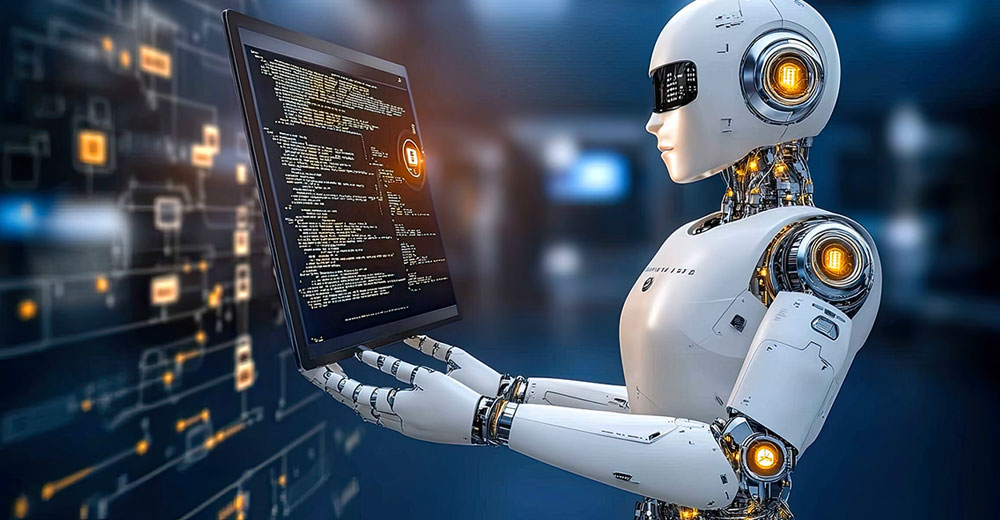The past year saw artificial intelligence (AI) push the boundaries of what’s possible, with industries racing to integrate its capabilities to boost productivity and automate complex tasks.
In 2024, AI advancements accelerated at a pace outstripping previous high-tech innovations, setting the stage for even greater disruption ahead. But with this rapid progress comes a risk: without human oversight, AI’s missteps could be just as monumental as its breakthroughs.
Generative and agentic AI are already enhancing users’ ability to obtain sophisticated content across various media, while AI-powered health care tools are reshaping diagnostics — outperforming human physicians in certain tasks. These developments signal a looming transformation in health care delivery, with AI poised to play an even bigger role in business and industrial operations.
The power of AI will also birth humanoid agents, noted Anders Indset, author and deep-tech investor in exponential technologies such as AI, quantum technology, health tech, and cybersecurity. As we step into 2025, the technology landscape is rapidly evolving, with a spotlight on humanoid agents.
“This year began with excitement surrounding large language models (LLMs) but is set to end with groundbreaking advancements in autonomous humanoid robots,” Indset told TechNewsWorld.
In 2024, the development of robots surged, with innovations that once seemed far off now coming into view. The long-anticipated release of fully autonomous humanoids — previously confined to industrial settings — is approaching, he observed.
The arrival of 2025 brings anticipation for the widespread adoption of AI in robotics, enhanced human-robot interactions, and the rise of robotics-as-a-service (RaaS) models. These will make advanced robotic solutions accessible to more industries, Indset explained, describing the ensuing transformative period for the robotics industry.
“Humanoid agents will reshape our interactions with technology and expand the possibilities for AI applications across different domains,” he predicted.
AI’s Expanding Role in Cybersecurity and Biosecurity
AI will play an increasingly critical role in cyberwarfare, warned Alejandro Rivas-Vasquez, global head of digital forensics and incident response at NCC Group. AI and machine learning (ML) will make cyberwarfare more deadly, with collateral damage outside of conflict zones due to hyper-connectivity, he offered.
Cybersecurity defenses, already a successful tool for digital warriors, will extend beyond protecting digital systems to safeguarding people directly through implantable technology. Neural interfaces, bio-augmentation, authentication chips, and advanced medical implants will revolutionize human interaction with technology.
According to Bobbie Walker, managing consultant at NCC Group, these innovations will also introduce significant risks.
“Hackers could exploit neural interfaces to control actions or manipulate perceptions, leading to cognitive manipulation and breaches of personal autonomy. Continuous monitoring of health and behavioral data through implants raises substantial privacy concerns, with risks of misuse by malicious actors or invasive government surveillance,” Walker told TechNewsWorld.
To mitigate these risks, new frameworks bridging technology, health care, and privacy regulations will be essential. Walker cautioned that standards for “digital bioethics” and ISO standards for bio-cybersecurity will help define safe practices for integrating technology into the human body while addressing ethical dilemmas.
“The emerging field of cyber-biosecurity will push us to rethink cybersecurity boundaries, ensuring that technology integrated into our bodies is secure, ethical, and protective of the individuals using it,” she added.
According to Walker, early studies on brain-computer interfaces (BCIs) show that adversarial inputs can trick these devices, highlighting the potential for abuse. As implants evolve, the risks of state-sponsored cyberwarfare and privacy breaches grow, emphasizing the need for robust security measures and ethical considerations.
AI-Driven Data Backup Raises Security Concerns
Sebastian Straub, principal solution architect at N2WS, stated that AI advancements better equip organizations to resume operations after natural disasters, power outages, and cyberattacks. AI automation will enhance operational efficiency by addressing human shortcomings.
AI-powered backup automation will reduce the need for administrative intervention to near zero, he explained. AI will learn the intricate patterns of data usage, compliance requirements, and organizational needs. Moreover, AI will become a proactive data management expert, autonomously determining what needs to be backed up and when, including adherence to compliance standards like GDPR, HIPAA, or PCI DSS.
But Straub warned that as this level of AI dominance dramatically transforms disaster recovery processes, errors will occur through the learning process. In 2025, we will see that AI is not a silver bullet. Relying on machines to automate disaster recovery will lead to mistakes.
“There will be unfortunate breaches of trust and compliance violations as enterprises learn the hard way that humans need to be part of the DR decision-making process,” Straub told TechNewsWorld.
AI’s Impact on Creativity and Education
For many AI users, tools to help improve communication skills are already in steady use. ChatGPT and other AI writing tools will emphasize the value of human writing rather than a workaround for personal language tasks.
Students and communicators will adjust from asking AI writing tools to produce work on their behalf to owning the content creation process from start to finish. They will leverage technology to edit, enhance, or expand original thinking, suggested Eric Wang, VP of AI at plagiarism detection firm Turnitin.
Looking ahead, Wang told TechNewsWorld that writing would be recognized as a critical skill, not just in writing-focused areas of study but also in learning, working, and living environments. This change will manifest as the humanization of technology-enabled fields, roles, and companies.
He sees the role of generative AI shifting, with early-stage usage helping to organize and expand ideas while later stages refine and enhance writing. For educators, AI can identify knowledge gaps early on and later provide transparency to facilitate student engagement.
Hidden Risks of AI-Powered Models
According to Michael Lieberman, CTO and co-founder of software development security platform Kusari, AI will become more widespread and challenging to detect. His concern lies with free models hosted on platforms.
“We have already seen cases where some models on these platforms were discovered to be malware. I expect such attacks to increase, though they will likely be more covert. These malicious models may include hidden backdoors or be intentionally trained to behave harmfully in specific scenarios,” Lieberman told TechNewsWorld.
He sees an increasing prevalence of data poisoning attacks aimed at manipulating LLMs and warns that most organizations do not train their own models.
“Instead, they rely on pre-trained models, often available for free. The lack of transparency regarding the origins of these models makes it easy for malicious actors to introduce harmful ones,” he continued, citing the Hugging Face malware incident as an example.
Future data poisoning efforts are likely to target major players like OpenAI, Meta, and Google, whose vast datasets make such attacks more challenging to detect.
“In 2025, attackers are likely to outpace defenders. Attackers are financially motivated, while defenders often struggle to secure adequate budgets since security is not typically viewed as a revenue driver. It may take a significant AI supply chain breach — akin to the SolarWinds Sunburst incident — to prompt the industry to take the threat seriously,” Turnitin’s Wang concluded.











